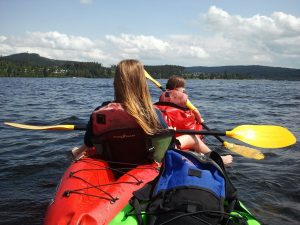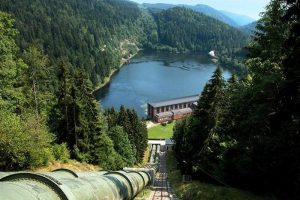Schluchsee
The Schluchsee is a reservoir in Schluchsee municipality near St. Blasien in the district of Breisgau-Hochschwarzwald in Baden-Württemberg. It lies south-east of the Titisee and is the largest lake in the Black Forest. At approximately 930 metres (3,050 ft) above sea level, it is the highest sailing area in Germany. The Schluchsee is a paradise for lovers of all kinds of open water and paddle sports. A natural ice rink forms here in winter, with an extensive network of cross-country ski trails around the lake; there is even a ski lift in Fischbach ski resort.
Since the 1960s, the lake has formed part of the Schluchseewerk hydropower complex in which a number of reservoirs are linked by pumping stations. In addition to the natural flow of water, the Schluchsee is replenished with water from the Rhine via a cascade of hydropower plants.

The Schluchsee was originally a glacial lake, part of the Feldberg glacier, and its surface was around 30 metres lower than that of today's reservoir, which was created by the impounding of the River Schwarza. From north-west to south-east, the lake is 7.3 km long and 1.4 km wide and reaches a maximum depth of 61 m.
 Also on offer: Canoes sometimes called Canadian canoes are fitted with two, three or four bench seats. Young children can comfortably sit in a row in the centre or find space on the floor. Stand-up paddleboarding is very popular and great fun. Sit-on-tops are a familiar sight in France and now they are available at the Schluchsee too: these kayaks have great stability when out on the water. Multi-person Canadian canoes are suitable for groups of up to 10 perfect for families.
The open-air Aqua Fun Centre in Schluchsee is situated close to the lake. Swim in the heated pool or take a dip in the much chillier lake definitely not for softies!
Schluchsee Sailing Club offers a range of courses and training options. www.segelverein-schluchsee.de
Also on offer: Canoes sometimes called Canadian canoes are fitted with two, three or four bench seats. Young children can comfortably sit in a row in the centre or find space on the floor. Stand-up paddleboarding is very popular and great fun. Sit-on-tops are a familiar sight in France and now they are available at the Schluchsee too: these kayaks have great stability when out on the water. Multi-person Canadian canoes are suitable for groups of up to 10 perfect for families.
The open-air Aqua Fun Centre in Schluchsee is situated close to the lake. Swim in the heated pool or take a dip in the much chillier lake definitely not for softies!
Schluchsee Sailing Club offers a range of courses and training options. www.segelverein-schluchsee.de 
 German rail operator Deutsche Bundesbahn aims to become climate-neutral. According to information provided by DB, the proportion of green energy used to power the railways is increasing rapidly, reaching 57 per cent in 2018.
No other form of transport is as eco-friendly as rail. DB aims to maximise this environmental benefit: its goal for 2030 is to halve carbon emissions in all its worldwide operations against the 2006 baseline and increase the renewables share in rails energy mix to 80 per cent, rising to 100 per cent by 2038. DBs target is to achieve climate neutrality by 2050.
German rail operator Deutsche Bundesbahn aims to become climate-neutral. According to information provided by DB, the proportion of green energy used to power the railways is increasing rapidly, reaching 57 per cent in 2018.
No other form of transport is as eco-friendly as rail. DB aims to maximise this environmental benefit: its goal for 2030 is to halve carbon emissions in all its worldwide operations against the 2006 baseline and increase the renewables share in rails energy mix to 80 per cent, rising to 100 per cent by 2038. DBs target is to achieve climate neutrality by 2050. Spoken by Kate

Schluchsee
The Schluchsee is a reservoir in Schluchsee municipality near St. Blasien in the district of Breisgau-Hochschwarzwald in Baden-Württemberg. It lies south-east of the Titisee and is the largest lake in the Black Forest. At approximately 930 metres (3,050 ft) above sea level, it is the highest sailing area in Germany. The Schluchsee is a paradise for lovers of all kinds of open water and paddle sports. A natural ice rink forms here in winter, with an extensive network of cross-country ski trails around the lake; there is even a ski lift in Fischbach ski resort.
Since the 1960s, the lake has formed part of the Schluchseewerk hydropower complex in which a number of reservoirs are linked by pumping stations. In addition to the natural flow of water, the Schluchsee is replenished with water from the Rhine via a cascade of hydropower plants.

The Schluchsee was originally a glacial lake, part of the Feldberg glacier, and its surface was around 30 metres lower than that of today's reservoir, which was created by the impounding of the River Schwarza. From north-west to south-east, the lake is 7.3 km long and 1.4 km wide and reaches a maximum depth of 61 m.
 Also on offer: Canoes sometimes called Canadian canoes are fitted with two, three or four bench seats. Young children can comfortably sit in a row in the centre or find space on the floor. Stand-up paddleboarding is very popular and great fun. Sit-on-tops are a familiar sight in France and now they are available at the Schluchsee too: these kayaks have great stability when out on the water. Multi-person Canadian canoes are suitable for groups of up to 10 perfect for families.
The open-air Aqua Fun Centre in Schluchsee is situated close to the lake. Swim in the heated pool or take a dip in the much chillier lake definitely not for softies!
Schluchsee Sailing Club offers a range of courses and training options. www.segelverein-schluchsee.de
Also on offer: Canoes sometimes called Canadian canoes are fitted with two, three or four bench seats. Young children can comfortably sit in a row in the centre or find space on the floor. Stand-up paddleboarding is very popular and great fun. Sit-on-tops are a familiar sight in France and now they are available at the Schluchsee too: these kayaks have great stability when out on the water. Multi-person Canadian canoes are suitable for groups of up to 10 perfect for families.
The open-air Aqua Fun Centre in Schluchsee is situated close to the lake. Swim in the heated pool or take a dip in the much chillier lake definitely not for softies!
Schluchsee Sailing Club offers a range of courses and training options. www.segelverein-schluchsee.de 
 German rail operator Deutsche Bundesbahn aims to become climate-neutral. According to information provided by DB, the proportion of green energy used to power the railways is increasing rapidly, reaching 57 per cent in 2018.
No other form of transport is as eco-friendly as rail. DB aims to maximise this environmental benefit: its goal for 2030 is to halve carbon emissions in all its worldwide operations against the 2006 baseline and increase the renewables share in rails energy mix to 80 per cent, rising to 100 per cent by 2038. DBs target is to achieve climate neutrality by 2050.
German rail operator Deutsche Bundesbahn aims to become climate-neutral. According to information provided by DB, the proportion of green energy used to power the railways is increasing rapidly, reaching 57 per cent in 2018.
No other form of transport is as eco-friendly as rail. DB aims to maximise this environmental benefit: its goal for 2030 is to halve carbon emissions in all its worldwide operations against the 2006 baseline and increase the renewables share in rails energy mix to 80 per cent, rising to 100 per cent by 2038. DBs target is to achieve climate neutrality by 2050. Spoken by Kate

HIER DIE ÜBERSCHRIFT
Schluchsee
The Schluchsee is a reservoir in Schluchsee municipality near St. Blasien in the district of Breisgau-Hochschwarzwald in Baden-Württemberg. It lies south-east of the Titisee and is the largest lake in the Black Forest. At approximately 930 metres (3,050 ft) above sea level, it is the highest sailing area in Germany. The Schluchsee is a paradise for lovers of all kinds of open water and paddle sports. A natural ice rink forms here in winter, with an extensive network of cross-country ski trails around the lake; there is even a ski lift in Fischbach ski resort.
Since the 1960s, the lake has formed part of the Schluchseewerk hydropower complex in which a number of reservoirs are linked by pumping stations. In addition to the natural flow of water, the Schluchsee is replenished with water from the Rhine via a cascade of hydropower plants.

The Schluchsee was originally a glacial lake, part of the Feldberg glacier, and its surface was around 30 metres lower than that of today's reservoir, which was created by the impounding of the River Schwarza. From north-west to south-east, the lake is 7.3 km long and 1.4 km wide and reaches a maximum depth of 61 m.
 Also on offer: Canoes sometimes called Canadian canoes are fitted with two, three or four bench seats. Young children can comfortably sit in a row in the centre or find space on the floor. Stand-up paddleboarding is very popular and great fun. Sit-on-tops are a familiar sight in France and now they are available at the Schluchsee too: these kayaks have great stability when out on the water. Multi-person Canadian canoes are suitable for groups of up to 10 perfect for families.
The open-air Aqua Fun Centre in Schluchsee is situated close to the lake. Swim in the heated pool or take a dip in the much chillier lake definitely not for softies!
Schluchsee Sailing Club offers a range of courses and training options. www.segelverein-schluchsee.de
Also on offer: Canoes sometimes called Canadian canoes are fitted with two, three or four bench seats. Young children can comfortably sit in a row in the centre or find space on the floor. Stand-up paddleboarding is very popular and great fun. Sit-on-tops are a familiar sight in France and now they are available at the Schluchsee too: these kayaks have great stability when out on the water. Multi-person Canadian canoes are suitable for groups of up to 10 perfect for families.
The open-air Aqua Fun Centre in Schluchsee is situated close to the lake. Swim in the heated pool or take a dip in the much chillier lake definitely not for softies!
Schluchsee Sailing Club offers a range of courses and training options. www.segelverein-schluchsee.de 
 German rail operator Deutsche Bundesbahn aims to become climate-neutral. According to information provided by DB, the proportion of green energy used to power the railways is increasing rapidly, reaching 57 per cent in 2018.
No other form of transport is as eco-friendly as rail. DB aims to maximise this environmental benefit: its goal for 2030 is to halve carbon emissions in all its worldwide operations against the 2006 baseline and increase the renewables share in rails energy mix to 80 per cent, rising to 100 per cent by 2038. DBs target is to achieve climate neutrality by 2050.
German rail operator Deutsche Bundesbahn aims to become climate-neutral. According to information provided by DB, the proportion of green energy used to power the railways is increasing rapidly, reaching 57 per cent in 2018.
No other form of transport is as eco-friendly as rail. DB aims to maximise this environmental benefit: its goal for 2030 is to halve carbon emissions in all its worldwide operations against the 2006 baseline and increase the renewables share in rails energy mix to 80 per cent, rising to 100 per cent by 2038. DBs target is to achieve climate neutrality by 2050. Spoken by Kate






